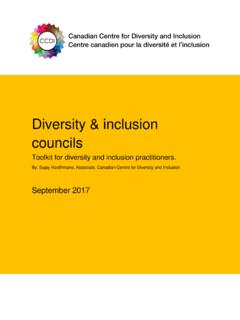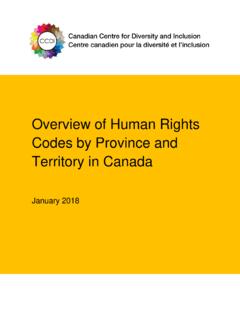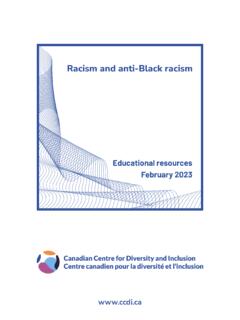Transcription of Getting Started Diversity and Identity - ccdi.ca
1 Getting Started | Diversity and Identity TOOLKIT. Acknowledgments We would like to thank the TELUS Greater Toronto Area Community Board for their generous contribution in supporting the development of this toolkit. We would also like to thank the members of our See Different Advisory Committee who have been instrumental in the success of this program and the development of this toolkit: Cecil Roach, Coordinating Superintendent of Equity and Community Services, York District School Board Danny DiLallo, Vice-Principal, York Catholic District School Board Laura Proctor, OCT. Maria Papadimitriou, MSc.
2 , MPH, CTDP. Thomas Sasso, MA, PhD Candidate, University of Guelph W. Y. Alice Chan, PhD Candidate, McGill University Art Direction and Graphic Design Calleja Design Cover Students from Castlebrooke (Peel District School Board). Authors Preeti Nayak, and Pam Malins, PhD. Contributor Yara Kodershah, Editor Wanda Santini, PhD. Copyright 2017 Canadian Centre for Diversity and Inclusion. All rights reserved. You may link to this document on our website, download it for personal use, or use a quote only if you include attribution and the page URL. If you intend to refer to it in another publication, please request permission at See Different | Preface Acknowledgments | 2.
3 Table of Contents PREFACE. Acknowledgments | 2. Introduction to the See Different Toolkits | 4. Teacher and Student Testimonials | 5. How to use these Toolkits | 6. TOOLKIT 1: Getting Started Diversity AND Identity | 8. Preliminary Readings: Build your Knowledge | 9. Overview of Toolkit 1 Activities | 12. 1 Introductions | 13. 2 Community Commitments | 14. 3 Icebreaker: Human Bingo | 16. 4 Diversity Kahoot Quiz | 17. 5 Identity Iceberg | 18. 6 Wrap-Up | 19. Facilitator Guides/Handouts | 20. See Different | Preface Table of Contents | 3. Introduction to the See Different Toolkits WHAT IS IT?
4 WHY SHOULD I USE IT? These toolkits include classroom or See Different was a successful high school extracurricular programming material to Diversity and inclusion training program support high school students in valuing and that reached over 500 students in five embracing Diversity and inclusion. Each school boards2 in Ontario. Its activities were toolkit contains: developed and revised based on positive comprehensive feedback from teachers professional development learning and students alike. Today, the program resources has been transformed into these toolkits, a facilitator manual for each activity with the intention of supporting teachers in student handouts, and their efforts to build a safer school climate.
5 A corresponding PowerPoint Through these toolkits, See Different presentation that includes continues to be a strong contributor to embedded multi-media resources the Canadian classroom. The toolkits help ( videos, images). users apply equity and inclusion strategies3. and connect to the following subject areas: Our toolkits cover the following topics: Canadian and World Studies, English, Diversity Guidance and Career Education, Arts, and Social Sciences and Humanities. We invite Identity all educators to bring See Different into power their schools. privilege allyship equality vs. equity conflict mediation leadership cross-cultural communication and social action.
6 The curriculum is a combination of activities that have been adapted from existing public resources along with original content created by Diversity consultants from the Canadian Centre for Diversity and Inclusion (CCDI)1. 2 See Different operated in the following school boards: Toronto Catholic District School Board (TCDSB), Peel District School Board (PDSB), Durham Catholic District School Board (DCDSB), York Regional District School Board (YRDSB) and York Catholic District School Board (YCDSB). 3 For example, Ontario's Equity and Inclusive Education 1 CCDI is the parent organization of See Different.
7 Strategy (2009). See Different | Preface Introduction | 4. Testimonials The program is well organized to take students (and teachers) through a gradual process of understanding Identity , bias, and how both intersect to shape ourselves and the world. The material is well layered to allow for an entry-point into the conversation for people at any level of understanding around these issues, and allows the development of a genuine connection between the concepts and the lives of its participants. Following that, the workshops provided an easy transition from reflection to action, and allowed students to examine the qualities of good campaigns so that they could develop their own within the school and/or greater community.
8 We received very positive reviews from both staff and students on our Unbox Yourself campaign, and the students really grew personally from the level of self-reflection and being able to take on a greater leadership role within the school. Nicole Luinenburg, Teacher | Castlebrooke , Peel District School Board I have learned that to make a more inclusive environment, you must be able to see things from another perspective. See Different student participant Through the modelling of inclusive language, reflection activities and explicit teaching of Allyship strategies, the See Different program empowered our student participants to have a more educated voice when raising issues that they saw to be unfair.
9 Sonia Wylie, Vice-Principal | All Saints , Durham Catholic District School Board See Different | Preface Testimonials | 5. How to use these Toolkits 1 Build your knowledge of Diversity and inclusion We highly recommend that teachers review the preliminary resources of each toolkit before delivering the workshop. A knowledgeable facilitator is needed to guide rich discussions with students. 2 Determine mode of delivery See Different can be delivered in several ways. It can be run as an extracurricular club, as a program integrated into a course, a stand-alone workshop, or you can simply pick and choose activities that you deem relevant for other contexts ( team-building exercise for a sports team, student retreat program, etc.)
10 Please note the concepts covered in Workshops 1 5 build on each other and increase in complexity. If you plan on delivering the full workshops, we recommend delivering the program in chronological order. The Master Toolkit is a compilation of Workshops 1 5. Below are a few logistical notes we invite you to consider depending on your mode of delivery: If you choose to integrate the program into your course, we recommend that See Different activities not be formally tested or evaluated1 to encourage more active and authentic student participation. Rather, use these activities as complementary materials to your core programming and encourage students to reflect on the work that they do as they progress through the workshops.







